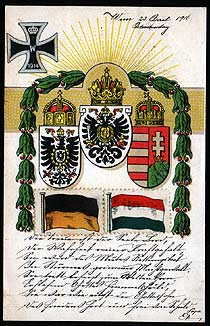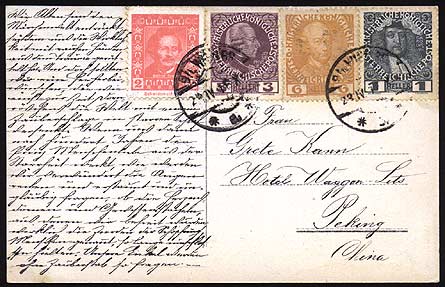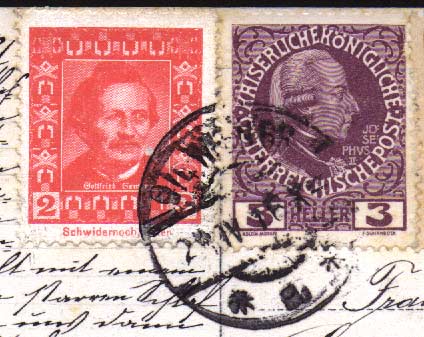 |
THE ROBITSCHEK CORRESPONDENCE PROJECT |  |
| April 23, 1916 - written to Mrs Grete Kann in Peking from Wien. | |

|
Papa Robitschek has modified this off-the-shelf patriotic card by adding the appropriate flag labels below the coats of arms and the sliver cross label at the upper left. This suggests that the card was carefully selected for its image, which places Austria at the heart of the Germanic world. Although the card appears, at first blush, to be about the War, this is not its primary concern. Rather, it is about being german and the tide of history, which is sweeping away the Austria of old and its ability to define the highest ideals of Germanic civilization.
The poem, on the surface about fidelty to the state, is really about using religious fidelity as a psychological shield against unreasonable actions of the state. The commentary on the reverse is an eliptical metaphore that discusses the likely consequences of this self deception. |
|
Die Treue ist der Seele Brod
Der Wahrheit reiner Kraftgehalt, Sie wird des Mutes Rettungsboot In Strumes grimmer Machtgewalt. Sie tritt beherzt zum Weltenthron, Emflehend Gottes Himmelshuld, Sie war wie einst der Gottesshon, Das Friedens Hort und Frei von Schuld. |
Fidelity is bread for the soul
The truth's pure strength, She becomes the spirit's rescue boat In the storm's raging might. She courageously steps before worlds throne Pleading God's heavenly grace, She was like once the sone of God Shelter for peace and free of guilt. |

| ||
|
Wir Alten sind dem
MƤrchenwelt entruckt seitdem uns die Wirklich- keit mit rauhen Händen aus dem Traume gerüt- telt hat. Und doch sollten wir eine Fee herbei- wünschen, die wie einst zur Zeit Dorn- röchens die Welt mit einem Zauberschlage in Narren Schlaf versenkt. Wenn uns dann nach hundert Yahren der Prinz Menschenlibe aus der Narrheit weckt, wie werden wir verundert die Augen reiben und erstaunt und un- gläubig fragen, ob die Herzens- dornen und Gewissenstacheln, aus denen wir befreit wurden, wirklich die Zierden der Schöpfunc Menschengemut, so lange umschlos- ssen heilten. Unsere Enkel werden ohne Zauberstal so fragen. |
Us old ones are snatched away
from the fairy tale world since reality with rough hands jolted us from our dreams. Even so we would wish for a fairy that, like once in the time of little Thornrose, sunk the world with a single magic beat into fools sleep. When after hundred years the Prince wakes human love from foolishness, we will rub our eyes with wonder and astonishingly and unbelievingly ask, if the heart throns and conscience pricks, of which we were freed, really healed creations glory, man's soul, that was locked so long. Our grandchildren will ask so without a magic wand. | |

|
This is the only card where the writer places a label in the writing space on the reverse of the card. This had to be planned in advance, since the label was was affixed before writing commenced.
Why? Well, to make room for three postage stamps, which means that these too were selected in advance. Three emperors on the back of the card, three crowns on the front. |
|
From 1908 to 1916, the lifetime of the definitive set, the emperors of Austria were matched to the postal rates so that the 10 Heller domestic rate was represented by Franz Joseph via a 10h stamp or, in the unlikely event of a shortage, by two 5h stamps of the same design. Remember, before 1908 Franz Joseph was on all the values of the definitive sets. Avoiding Franz Joseph and the current regime, our writer selected the smallest number of stamps required to make up the rate, using Joseph II, Leopold II and Karl VI. This necessitated encroachment into the writing space at the left of the card in order to include the label of Gottfried Semper. From this we can infer that his inclusion was probably important to the writer. Why?
As a revolutionary young German architect, Gottfried Semper (1803-1879) participated in the liberal intellectual movement of the mid 1840s, culminating in his participation in the Dresden revolt. This movement was brutally repressed in 1849 by the aristocracy led by Count Windischgraetz. Semper fled to England and eventually rose phoenix-like from the ashes to become the greatest architect in Europe. He finished his career in Vienna, where he designed the two great museums on the Heldenplatz. Semper first came to prominence in Dresden, where he designed and built the largest synagogue in Germany. His selection for this card is the first hint we get that the writer is Jewish, a fact which becomes clear later in the correspondence. Semper was German, not Austrian, and this tells us where the sympathies of our mystery writer lie. As the writing in the correspondence becomes more Jewish in its content and cadence, the author sheds his early German persona that we see in the cards of 1916 and 1917. Finally, curiously, the poem on the front of the card is about fidelity and two reviewers of biographies of Gottfried Semper have used the familiar phrase, "Semper Fidelis", to describe the quality of Semper's life. This may have been a quality that the author wished to exemplify by selecting a label depicting Semper - a brilliant and ambitious mind who served both the state and a higher calling that was often at odds with the powers controlling Europe. And Semper certainly qualified as one of the "old ones" snatched from his faerie dreams. Although an intellectual giant in architecture, whose theoretical works are still employed to good effect, his material designs were frequently far more extensive than could be achieved in reality. His plan for an enormous setting for Wagner's works came to nothing. And his vision for the greater Heldenplatz was only partially realized some two decades after his death. Did God awaken him to witness the decline of the Monarchy or flames of hate devouring his temple to the divine in Dresden? We do not know. But we do know that his intellectual descendents had no magic with which to confront the world - only dreams. |
|
 |
THE ROBITSCHEK CORRESPONDENCE PROJECT |  |